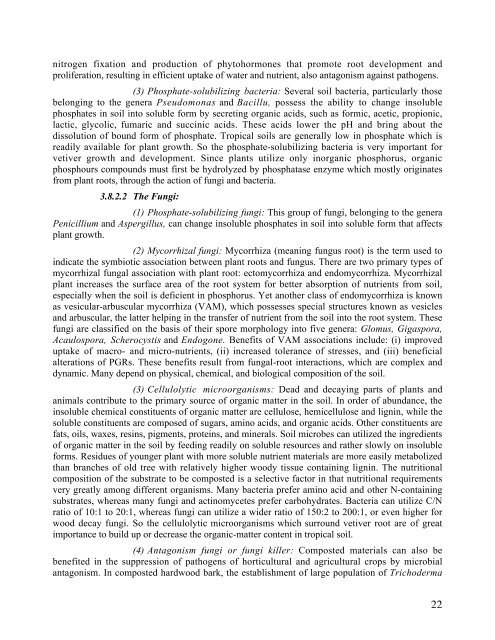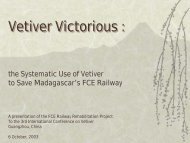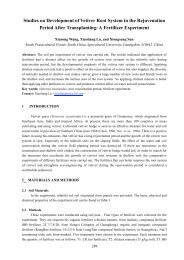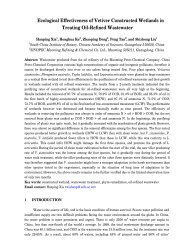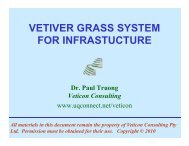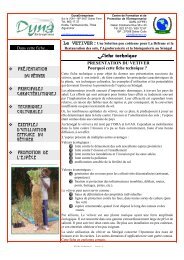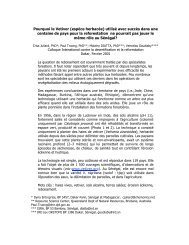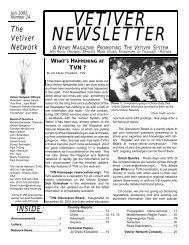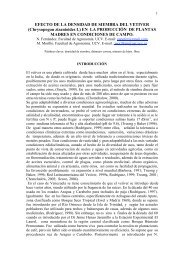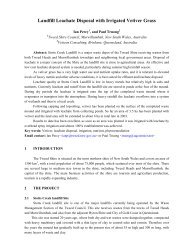Training manual - The Vetiver Network International
Training manual - The Vetiver Network International
Training manual - The Vetiver Network International
Create successful ePaper yourself
Turn your PDF publications into a flip-book with our unique Google optimized e-Paper software.
nitrogen fixation and production of phytohormones that promote root development and<br />
proliferation, resulting in efficient uptake of water and nutrient, also antagonism against pathogens.<br />
(3) Phosphate-solubilizing bacteria: Several soil bacteria, particularly those<br />
belonging to the genera Pseudomonas and Bacillu, possess the ability to change insoluble<br />
phosphates in soil into soluble form by secreting organic acids, such as formic, acetic, propionic,<br />
lactic, glycolic, fumaric and succinic acids. <strong>The</strong>se acids lower the pH and bring about the<br />
dissolution of bound form of phosphate. Tropical soils are generally low in phosphate which is<br />
readily available for plant growth. So the phosphate-solubilizing bacteria is very important for<br />
vetiver growth and development. Since plants utilize only inorganic phosphorus, organic<br />
phosphours compounds must first be hydrolyzed by phosphatase enzyme which mostly originates<br />
from plant roots, through the action of fungi and bacteria.<br />
3.8.2.2 <strong>The</strong> Fungi:<br />
(1) Phosphate-solubilizing fungi: This group of fungi, belonging to the genera<br />
Penicillium and Aspergillus, can change insoluble phosphates in soil into soluble form that affects<br />
plant growth.<br />
(2) Mycorrhizal fungi: Mycorrhiza (meaning fungus root) is the term used to<br />
indicate the symbiotic association between plant roots and fungus. <strong>The</strong>re are two primary types of<br />
mycorrhizal fungal association with plant root: ectomycorrhiza and endomycorrhiza. Mycorrhizal<br />
plant increases the surface area of the root system for better absorption of nutrients from soil,<br />
especially when the soil is deficient in phosphorus. Yet another class of endomycorrhiza is known<br />
as vesicular-arbuscular mycorrhiza (VAM), which possesses special structures known as vesicles<br />
and arbuscular, the latter helping in the transfer of nutrient from the soil into the root system. <strong>The</strong>se<br />
fungi are classified on the basis of their spore morphology into five genera: Glomus, Gigaspora,<br />
Acaulospora, Scherocystis and Endogone. Benefits of VAM associations include: (i) improved<br />
uptake of macro- and micro-nutrients, (ii) increased tolerance of stresses, and (iii) beneficial<br />
alterations of PGRs. <strong>The</strong>se benefits result from fungal-root interactions, which are complex and<br />
dynamic. Many depend on physical, chemical, and biological composition of the soil.<br />
(3) Cellulolytic microorganisms: Dead and decaying parts of plants and<br />
animals contribute to the primary source of organic matter in the soil. In order of abundance, the<br />
insoluble chemical constituents of organic matter are cellulose, hemicellulose and lignin, while the<br />
soluble constituents are composed of sugars, amino acids, and organic acids. Other constituents are<br />
fats, oils, waxes, resins, pigments, proteins, and minerals. Soil microbes can utilized the ingredients<br />
of organic matter in the soil by feeding readily on soluble resources and rather slowly on insoluble<br />
forms. Residues of younger plant with more soluble nutrient materials are more easily metabolized<br />
than branches of old tree with relatively higher woody tissue containing lignin. <strong>The</strong> nutritional<br />
composition of the substrate to be composted is a selective factor in that nutritional requirements<br />
very greatly among different organisms. Many bacteria prefer amino acid and other N-containing<br />
substrates, whereas many fungi and actinomycetes prefer carbohydrates. Bacteria can utilize C/N<br />
ratio of 10:1 to 20:1, whereas fungi can utilize a wider ratio of 150:2 to 200:1, or even higher for<br />
wood decay fungi. So the cellulolytic microorganisms which surround vetiver root are of great<br />
importance to build up or decrease the organic-matter content in tropical soil.<br />
(4) Antagonism fungi or fungi killer: Composted materials can also be<br />
benefited in the suppression of pathogens of horticultural and agricultural crops by microbial<br />
antagonism. In composted hardwood bark, the establishment of large population of Trichoderma<br />
22


